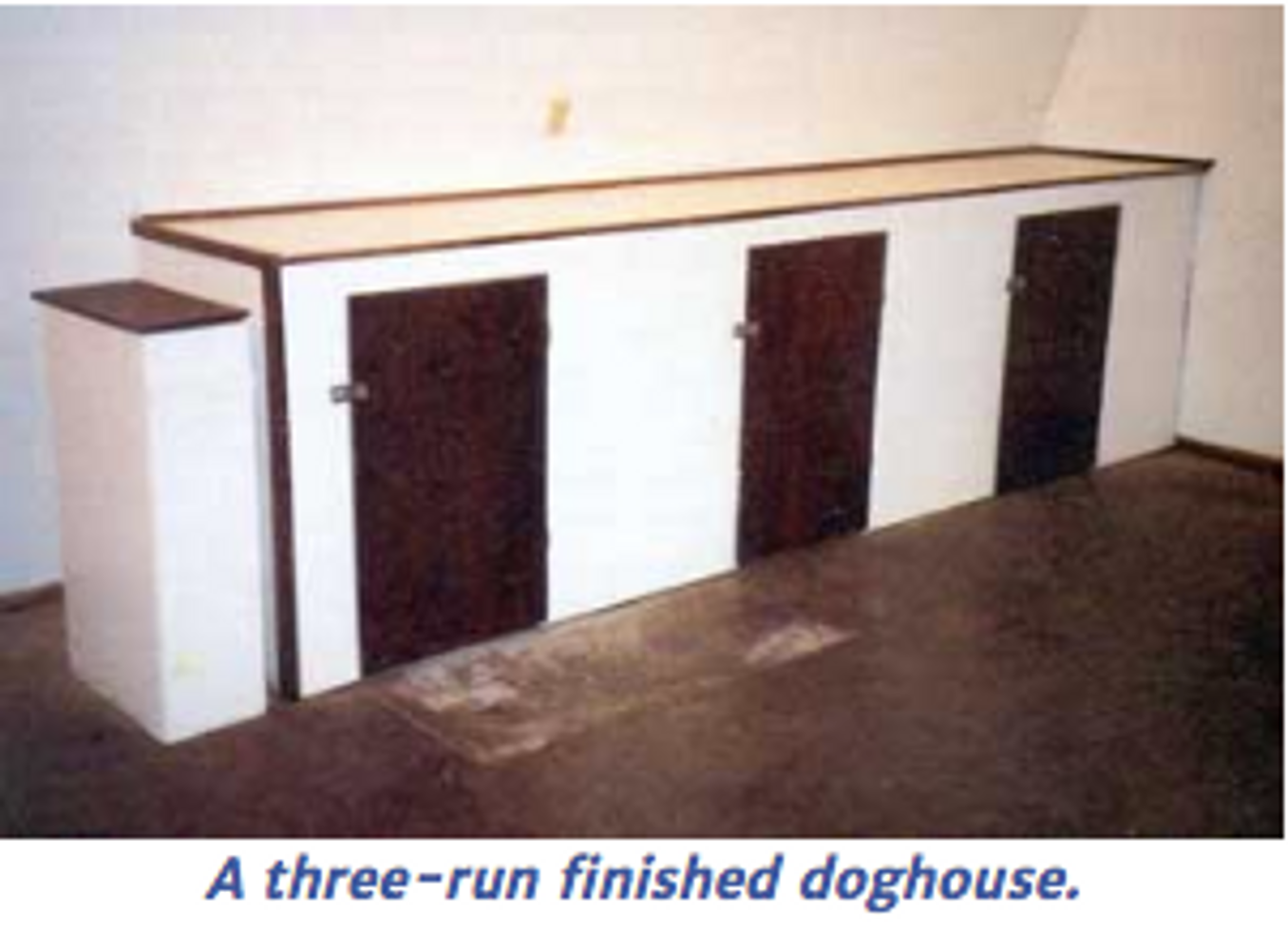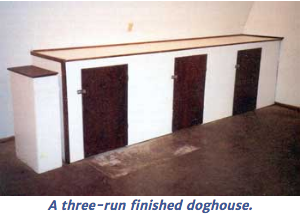
A whelping box for dogs (or puppy birthing box) does not have to be an individual box in your house, basement or garage, where constant attention to cleanup duty makes having a litter of pups a burden on your hectic daily lifestyle. The design I am going to show you works extremely well for our lifestyle because we are not home during the day to tend to mother and pups. In constructing the dog whelping pen to my kennel run and doghouse, mother and pups have access to outside fresh air. The design I am going to show you will make feeding, cleaning and handling a litter of pups efficient and easy.
In the July/August 1988 issue of Gun Dog magazine, pages 39-40, I illustrated a doghouse and dog kennel design attached to a shed or garage, etc. The doghouse built inside a building makes an excellent work bench and allows easy access to the dog during poor weather conditions. Let’s take a look at how you can convert this doghouse into a collapsible, reusable whelping box.
The original doghouse floor area is approximately four feet wide and four feet long. This floor area is not large enough for raising a litter of pups. A small floor area could lead to trouble with mother hurting the pups by laying on them. So let’s add an inside addition to the doghouse. Our first step is to remove the inside door, wall panels, insulation and doghouse floor and expand the floor area in additional two feet. After removing the inside wall a 2” thick x 4’ wide x 6’ long piece of high density polystyrene is placed directly on the floor. Cover the insulation with _” smooth-surfaced plywood. Rough cut plywood should not be used for building a puppy whelping box because it can cause skin irritation during the first few weeks of puppy growth due to the rough sharp wood surface.
With the floor laid, frame up the extended doghouse walls. I used 2”x 2” pine for the framed walls. I am constructing a non-insulated inside wall because my shop is insulted and heated I would encourage you to thoroughly insulate a 2” x 4” wall surface which is covered by _” plywood. Your method of wall framing may vary. Note in my photos I installed a 2” x 2” plate on the plywood floor surface and sheeted over the outside of the framed walls. Continue reading below for photos and a step by step guide on how to build a whelping box for puppies.
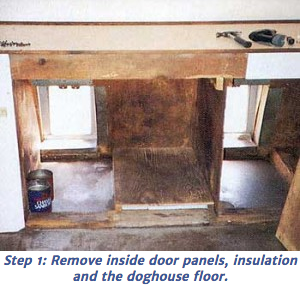
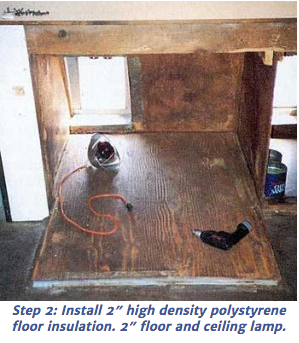
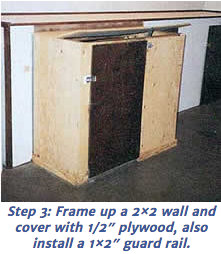
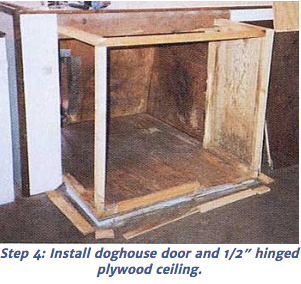
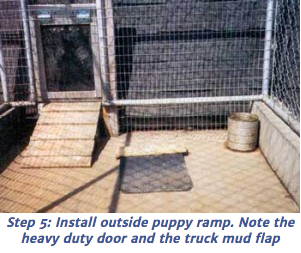
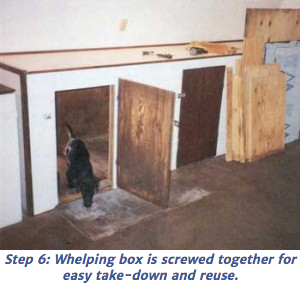
Whelping Box Step 1
Step 1: Remove inside door panels, insulation and the doghouse floor.
Whelping Box Step 2
Step 2: Install 2″ high density polystyrene
floor insulation. 2″ floor and ceiling lamp.
Whelping Box step 3
Step 3: Frame up a 2×2 wall and cover with 1/2″ plywood, also install a 1×2″ guard rail.
Whelping Box step 4
Step 4: Install doghouse door and 1/2″ hinged plywood ceiling.
Whelping Box step 5
Step 5: Install outside puppy ramp. Note the heavy duty door and the truck mud flap
Whelping Box step 6
Step 6: Whelping box is screwed together for easy take-down and reuse.
After covering the walls with 1/2” plywood, it’s important to install a floor railing. The railing will help protect against loss of pups due to being laid on by mother during the first few weeks of growth. I use a 1” x 2” pine installed three inches off the floor. A 1” spacer is inserted behind the railing at 2’ intervals to bring it away from the wall. The railing should be screwed in place with 2 1/2” sheetrock screws because you can remove it after two to three weeks of pup growth, allowing mother and pups additional space.
MATERIAL LIST
Framing
2 x 2’s or 2 x 4’s28’
Floor/walls
1/2” plywood2.5-4 x 8” sheets
Floor insulation 2” polystyrene1-4 x 8” sheet
Door (use existing door)
Guardrail 1 x 2” pine16’
Sheetrock screws
1 1/2” and 2 1/2”50
3” hasp latch1
2” hinges2
X- heat lamp location (red bulb)
TOOLS
Table saw or circular saw
Drill-screwdriver bit
Hammer
The ceiling for the addition can be made with 1/2” plywood. Be sure to insulate the ceiling if you construct your addition in an uninsulated building. Note in the photos how I cut the plywood ceiling in half and install a hinged ceiling with a locking hasp latch. I find this feature is important for me because when the pups are first born I can view them without disturbing mom. As the pups get older, I use the top access door to feed them. This way I don’t get mauled by the pups in the morning when I’m on my way to work.
Use the original indoor doghouse door for your inside access. You are going to want this door because you will be cleaning the dog whelping box almost daily when the pups get five weeks and older. I always have a good door on the outside. For the first four weeks of pup growth a heavy duty plexiglass door allows for a draft free whelping box. It is important to construct a 1” x 5” high barrier in front of the outside access door. This allows only mother to go outside. Naturally young pups should not be allowed outside during this growth period. As the pups develop eyesight and mobility a light swinging truck mud flap is installed so the pups have outside access without door restriction or potential injury problems caused by the heavy door. Because the outside door is 10 inches off the kennel floor, a small ramp is installed. The 1/2” x 12” wide plywood ramp has four 1/2” x 1” x 12” steps and a 2” x 4” underneath it for added strength. I always screw the ramp to my building, otherwise the pups use it as a toy.
One more item should be installed and that’s a heating system. There are heat pads with thermostat controls available on the market. I like the use of a heat lamp with an insulated bulb socket that has a metal cage lamp protector. You can now buy lamps with red bulbs which eliminate direct bright problems caused by clear bulbs. I install the lamp approximately two feet in front of the outside door, directing the lamp to the center of the floor. Always monitor floor temperature. A timer can be used to turn of the heat lamp if you expect daytime temperatures to rise.
The construction details I have shown you are held together with various sizes of sheetrock screws so that your whelping box can be easily taken apart and available for reuse. This design will allow you to provide a safe environment for your puppies and simplify your cleaning and feeding chores.
